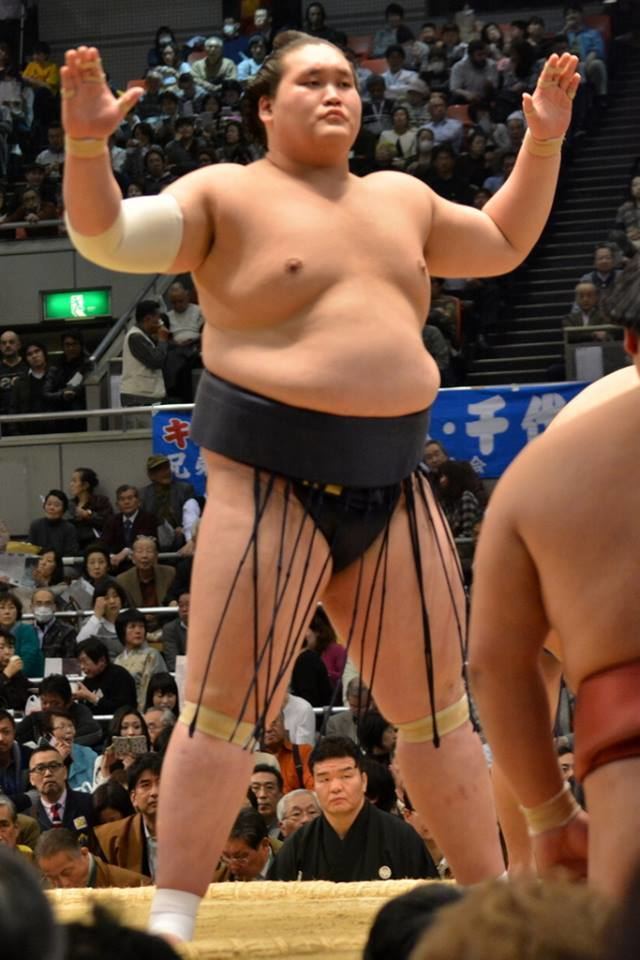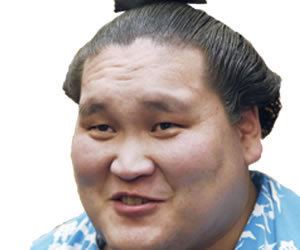Current rank see below Name Terunofuji Haruo | Debut January, 2011 Height 1.91 m Highest rank Ozeki (July, 2015) Weight 178 kg | |
 | ||
Born Gantulga Ganerdene November 29, 1991 (age 33) Ulan-Bator, Mongolia ( 1991-11-29 ) Special Prizes Fighting Spirit (3)Outstanding Performance (1) | ||
Championships 1 (Makuuchi)1 (Juryo) | ||
Terunofuji Haruo (born 29 November 1991 as Gantulga Ganerdene) is a sumo wrestler from Ulan-Bator, Mongolia. He entered sumo in January 2011, and took the second division jūryō championship in his debut as a sekitori in September 2013. He took the top makuuchi division championship in May 2015, only 25 tournaments after his professional debut, which is third behind the renowned Asashōryū and Takanohana's 23 tournaments. This earned him promotion to sumo's second highest rank of ōzeki. He has been runner-up in four other tournaments, and has four special prizes for Fighting Spirit and Outstanding Performance. He has suffered from knee injuries and has been kadoban or in danger of demotion from the rank of ozeki four times in his career. He wrestles for Isegahama stable.
Contents

Early life and sumo background

In childhood, Ganerdene was coached in judo by the father of yokozuna Hakuhō, but, his coach saw in him a predisposition for sumo and helped arrange for him to move to Japan as a student at Tottori Johoku High School to join its well-known sumo program. Future top division wrestler Ichinojō travelled with him and joined the same school. (He continued his rivalry with Ichinojō into the professional ranks, remarking in 2015, "What matters is who will make it to the ozeki rank first.") As a third year student, Ganerdene's team took the championship at a national inter-high school sumo tournament.
Early career

Upon graduating, he chose to turn professional and joined Magaki stable. He entered the ring in the same tournament as soon to be well-known Chiyotairyū and Jōkōryū. Upon entering he was given the ring name of Wakamishō. From his first pro tournament in July 2011 he excelled, posting only three losses in three tournaments and spending only one tournament in each of the lower divisions of jonokuchi, jonidan and sandanme. In his sandanme tournament in November 2011, he had a perfect 7–0 record and participated in a playoff for the championship, which he lost to the aforementioned Jōkōryū, then still known as Sakumayama. From his third division makushita debut in January 2012, he had three consecutive 5–2 records before posting two consecutive losing tournaments in July and September 2012, the only two of his career up to that point. He bounced back from this in the following November tournament, garnering a 4–3 record. For the next four tournaments his success continued and he never had more than two losses in any tournament. During the period, his stable closed, and he transferred to Isegahama stable. He had become frustrated with a lack of training opportunities at the small Magaki stable, and at Isegahama by contrast he was able to practice with many higher ranked wrestlers to improve his technique. His 6–1 record at makushita 4 in July 2013 was enough to earn him promotion to the salaried ranks of jūryō in September 2013.
Upon entering jūryō he changed his ring name to Terunofuji, a combination of two former yokozuna, Terukuni and Asahifuji (his own stablemaster), and a reflection of the high expectations placed on him. He took the jūryō championship in his debut tournament, beating future maegashira Kagamiō on the last day to even their records and forcing a playoff bout against Kagamiō, which he also won. This success followed in the footsteps of the popular Endō who in the previous tournament also took the jūryō championship in his debut in said division. An 8–7 record in the following November tournament and an even more impressive 12–3 record against a host of wrestlers with makuuchi experience in the January 2014 tournament earned him promotion to the top makuuchi division in March 2014.
Makuuchi division

His debut in the makuuchi division looked to be a disaster, and he had only a 2–7 record on the 9th day. However, from then on he won 6 straight bouts in 6 days to pull out a kachi-koshi or winning tournament. Then in the following May tournament he started out with an unpromising 4–6 record, but then won 5 straight to finish with a strong showing of 9–6. Two tournaments later in the September 2014 tournament at maegashira 1 he was up against top notch competition, including several san'yaku or titled wrestlers, and he only managed to eke out an 6–9 record. This was only his third make-koshi or losing record in a tournament in his career and his first in the salaried rank. He only fell to maegashira 2 though, being helped by bad showings from several other wrestlers. It was in this tournament in November 2014 that he truly began to show his mettle in the top division; after going only 4–6, he beat an ōzeki and two sekiwake in the last 5 days to pull off an 8–7. In the January 2015, he defeated the ōzeki Gōeidō and Kisenosato, the sekiwake Aoiyama and both active komusubi on the way to an 8–7 record. He was awarded the Fighting Spirit Prize, his first special prize.
He was promoted to the rank of sekiwake for the next tournament. In the March Grand Tournament of 2015, he defeated yokozuna Hakuhō (unbeaten in his last 36 matches) for the first time in four meetings, and finished runner-up with a 13–2 record, having also defeated both komusubi as well as the ōzeki Gōeidō and Kotoshōgiku. He received his second Fighting Spirit Prize and was also awarded the prize for Outstanding Performance. After his final contest he said "I’ll shoot for double-digit wins at the next tournament and hopefully that will lead to victory. Now I just want to take a long rest". In May Terunofuji was beaten on the opening day of the Natsu basho by Sadanoumi, but won his next seven including victories over both komusubi and the ōzeki Kotoshōgiku. After defeats by Tokushōryū on day nine and Hakuhō on day eleven he recovered to win his next three matches including victories over Kisenosato and the sekiwake Myōgiryū to enter the final day in a tie for first place with Hakuhō. In his final match he defeated the Bulgarian maegashira Aoiyama by yori-kiri or force-out, and then saw Hakuhō lose to Harumafuji. The result was that Terunofuji, in his eighth top-division tournament, was handed his first championship with a 12–3 record and was awarded the Fighting Spirit Prize for the third time. Terunofuji admitted that he had been "almost in tears" at the conclusion of the tournament and said, "When I was 15 years old I watched sumo and wanted to become a sumo wrestler and so came to Japan. It was a dream of mine to win the championship. To actually win it is like a dream." A few days after the tournament, Terunofuj's official promotion to ōzeki was announced in a press conference.
Ōzeki
On his first appearance at his new rank Terunofuji won nine of his first ten matches to reach a tie for the lead, but losses to Hakuhō, Kakuryū and Kotoshōgiku saw him end the tournament with an 11–4 record. In September he won his first eleven matches to establish a clear lead over the opposition, but then lost to Tochiōzan and Kisenosato, sustaining a knee injury in the latter match. Another loss to Gōeidō saw him enter the final day with eleven wins, one behind the yokozuna Kakuryū. In the final scheduled match on day 15 Terunofuji defeated Kakuryū to level their scores but lost the ensuing play-off. Terunofuji's knee injury continued to trouble him in November but he posted nine wins including victories over the yokozuna Kakuryū and Hakuhō.
In January 2016 Terunofuji won three of his first five bouts before withdrawing from the tournament with a broken right collar bone and damaged meniscus in his left knee, after a bout with Kyokushūhō. This was the first withdrawal of his career. He underwent arthroscopic surgery on his left knee shortly afterwards. Despite his injury problems he announced that he would contest the next tournament in March, where he was kadoban, or in danger of demotion from ōzeki rank. In March 2016, Terunofuji still seemed well below his best, but maintained his rank with eight wins. In May however his form slumped as he lost his last thirteen matches to end with a career-worst record of 2–13. He just managed to preserve his rank on the final day of the following Nagoya tournament by defeating Kaisei for an 8–7 record, but was kadoban yet again after recording only four wins in September. In November 2016 things didn't look good as he was kadoban and under danger of demotion if he failed to secure at least eight wins in the tournament. Things didn't start off on the right foot as he lost his first two matches, however things took a turn as he proceeded to win the next seven in a row including a win over fellow ōzeki Kotoshōgiku. Terunofuji then had two losses against Kakuryū and Gōeidō, but was able to get his winning record on day 12 against Hakuhō which erased his kadoban status and secured his rank. Terunofuji did however go on to lose the remaining three days of the tournament ending with an 8–7 record. 2016 was a hard year for Terunofuji, with the lack of strength and flexibility in his knees affecting his performances. He was kadoban three times, but was able to hold on to his rank each time by getting a winning record in the following tournament.
The January 2017 tournament didn't bode well for Terunofuji as he managed only four wins, making him kadoban for the fourth time. The Osaka tournament in March saw a dramatic return to form as he won his first five matches before losing to Takayasu, and then won his next seven to take a share of the lead with a win over Kakuryū on Day 13. On Day 14 he became the sole leader after he defeated Kotoshōgiku and the injured Kisenosato lost to Kakuryū, but he was booed by the crowd for sidestepping his opponent at the initial charge. He missed out on his second yusho on the final day as he was defeated twice by Kisenosato, once in their regulation match and again in the resulting playoff. The Japan Sumo Association was questioned by the government after the tournament when media reports suggested that Terunofuji was subjected to hate speech taunts from the crowd after his controversial win over Kotoshōgiku, with the expression "Go back to Mongolia" reportedly used.
Terunofuji underwent endoscopic surgery on his left knee after the May 2017 tournament, but did not recover as well as expected. He entered the Nayoga tournament in July but withdrew after four losses in the first five days, citing a meniscal injury to the knee. The September tournament saw a repeat of Nagoya, with Terunofuji winning only one of his first five matches before he was forced to withdraw because of the knee injury, which he aggravated in a loss to Shohozan on Day 5. Having failed to record a winning score in two consecutive tournaments he will lose his ōzeki status after more than two years at the rank.
Fighting style
Terunofuji is a yotsu-sumo wrestler who favours grappling techniques as opposed to pushing and thrusting (oshi-sumo). His preferred grip on his opponent's mawashi or belt is migi-yotsu, a left hand outside, right hand inside position. His favourite winning kimarite or technique is a straightforward yori-kiri, or force out, which has accounted for over 40 percent of his career victories.
